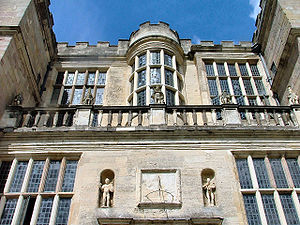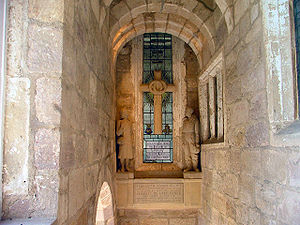
Fountains Hall
Encyclopedia
..jpg)
Ripon
Ripon is a cathedral city, market town and successor parish in the Borough of Harrogate, North Yorkshire, England, located at the confluence of two streams of the River Ure in the form of the Laver and Skell. The city is noted for its main feature the Ripon Cathedral which is architecturally...
in North Yorkshire
North Yorkshire
North Yorkshire is a non-metropolitan or shire county located in the Yorkshire and the Humber region of England, and a ceremonial county primarily in that region but partly in North East England. Created in 1974 by the Local Government Act 1972 it covers an area of , making it the largest...
, England
England
England is a country that is part of the United Kingdom. It shares land borders with Scotland to the north and Wales to the west; the Irish Sea is to the north west, the Celtic Sea to the south west, with the North Sea to the east and the English Channel to the south separating it from continental...
, close to the World Heritage Site
World Heritage Site
A UNESCO World Heritage Site is a place that is listed by the UNESCO as of special cultural or physical significance...
of Fountains Abbey
Fountains Abbey
Fountains Abbey is near to Aldfield, approximately two miles southwest of Ripon in North Yorkshire, England. It is a ruined Cistercian monastery, founded in 1132. Fountains Abbey is one of the largest and best preserved Cistercian houses in England. It is a Grade I listed building and owned by the...
. It belongs to the National Trust
National Trust for Places of Historic Interest or Natural Beauty
The National Trust for Places of Historic Interest or Natural Beauty, usually known as the National Trust, is a conservation organisation in England, Wales and Northern Ireland...
as part of its Fountains Abbey & Studley Royal Water Garden
Studley Royal Park
Studley Royal Park is a park containing, and developed around, the ruins of the Cistercian Fountains Abbey in North Yorkshire, England. It is a World Heritage Site. The site also contains features dating from the eighteenth century such as Studley Royal Water Garden.-Origins:The Fountains Abbey was...
property, and is a Grade I listed building.
The house was built by Stephen Proctor between 1598 and 1604, partly with stone from the Abbey ruins. It is a fine example of late Elizabethan architecture, perhaps influenced by the work of Robert Smythson
Robert Smythson
Robert Smythson was an English architect. Smythson designed a number of notable houses during the Elizabethan era. Little is known about his birth and upbringing—his first mention in historical records comes in 1556, when he was stonemason for the house at Longleat, built by Sir John Thynne...
. After Proctor's death in 1619, Fountains Hall passed into the possession of the Messenger family, who sold it to William Aislabie of neighbouring Studley Royal
Studley Royal Park
Studley Royal Park is a park containing, and developed around, the ruins of the Cistercian Fountains Abbey in North Yorkshire, England. It is a World Heritage Site. The site also contains features dating from the eighteenth century such as Studley Royal Water Garden.-Origins:The Fountains Abbey was...
one hundred and fifty years later. Fountains Hall became virtually redundant as the Aislabie family remained at Studley Royal. It was leased to various tenants and at one time parts of it were used for farm storage. However it was renovated and modernised between 1928 and 1931, and the Duke and Duchess of York (later King George VI
George VI of the United Kingdom
George VI was King of the United Kingdom and the Dominions of the British Commonwealth from 11 December 1936 until his death...
and Queen Elizabeth
Elizabeth Bowes-Lyon
Elizabeth Angela Marguerite Bowes-Lyon was the queen consort of King George VI from 1936 until her husband's death in 1952, after which she was known as Queen Elizabeth The Queen Mother, to avoid confusion with her daughter, Queen Elizabeth II...
) often stayed there as guests of Lady Doris Vyner, wife of the Marquis of Ripon and sister to the then-current Duke of Richmond and Gordon.

Evacuations of civilians in Britain during World War II
Evacuation of civilians in Britain during the Second World War was designed to save the population of urban or military areas in the United Kingdom from aerial bombing of cities and military targets such as docks. Civilians, particularly children, were moved to areas thought to be less at risk....
. Studley Royal became the wartime home of Queen Ethelburga's School of Harrogate, while the Q.E. Sanatorium was over at Fountains Hall. The stable block with the courtyard, set apart from the house at Studley Royal, was used for dormitaries while one corner became the School Chapel, at which Sunday Evensong was regularly said by the Arch Deacon at Ripon.
It has a balcony of note, although it cannot be used at present because the second floor is used for weddings and the staircase is considered unsafe for the public.


Royal Naval Reserve
The Royal Naval Reserve is the volunteer reserve force of the Royal Navy in the United Kingdom. The present Royal Naval Reserve was formed in 1958 by merging the original Royal Naval Reserve and the Royal Naval Volunteer Reserve , a reserve of civilian volunteers founded in 1903...
pilot missing in action near Rangoon. Elizabeth was a member of the Women's Royal Naval Service and died of lethargic encephalitis while on service in Felixstowe, Suffolk. There is a sculpture remembering them which can be seen as one comes out of the house down the stone stairs.
WHEN YOU GO HOME
TELL THEM OF US
AND SAY
FOR YOUR TOMORROW
WE GAVE OUR TODAY
FROM THIS THEIR HOME, THEY WENT TO WAR.
Elizabeth Vyner WRNS - Died on Active Service June 3rd 1942 Aged 18 years. Also her brother Charles De Grey Vyner Sub Lieut (A) RNVR Reported missing from Air Operations Off Rangoon May 2nd 1945 Aged 19 Years.
After the war the Hall again fell into a state of serious dilapidation.
The National Trust acquired the Fountains Estate from North Yorkshire County Council in 1983 and has been undertaking restoration work on the Hall since then. Part of it has been divided into flats, one of which is available for holiday lets. Visitors to Fountains Abbey can view the oak-paneled Stone Hall and an adjoining exhibition room, and there are plans to restore the chapel.

